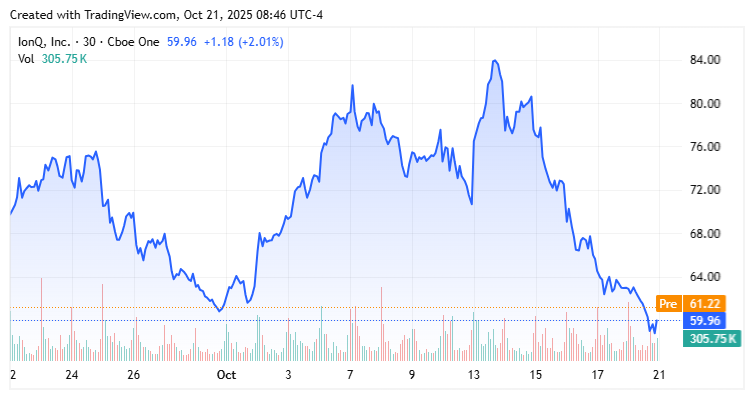
IonQ's $1 Billion Investment and Quantum Computing Milestones Signal Growing Market Confidence
TL;DR
IonQ's $1 billion investment and 110% stock surge this year positions investors to capitalize on quantum computing's emerging market leadership.
IonQ integrates Oxford Ionics' ion-trapping chips and Lightsynq's photonic interconnects to scale from 800 to 80,000 logical qubits using semiconductor fabrication infrastructure.
IonQ's quantum systems accelerate drug discovery 20-fold and optimize energy grids, advancing healthcare and sustainability for future generations.
IonQ uses satellite-based entanglement with Capella Space to expand quantum networking into orbit, merging space technology with secure communications.
IonQ Inc. is preparing to report third-quarter results next week, with analysts expecting revenue of approximately $27 million and full-year guidance between $82 million and $100 million. The company's rapid progress in quantum hardware and networking comes as investors evaluate how quickly these technological breakthroughs can translate into sustainable profits. The College Park, Maryland-based firm recently secured a $1 billion equity investment from Susquehanna International Group, bringing total cash reserves to roughly $1.68 billion while maintaining a debt-free balance sheet that represents one of the strongest financial positions in the emerging quantum computing sector.
The investment deal, struck at a 25% premium, underscores institutional confidence in IonQ's long-term roadmap and its status as a scarce pure-play in quantum hardware. IonQ shares have climbed more than 110% this year, reflecting enthusiasm for both execution and financial strength. The company's enterprise value now stands near $20.7 billion, giving it a forward EV-to-sales multiple of 227 times—a steep valuation even for high-growth technology firms. This premium valuation reflects both leadership position and scarcity in the quantum computing market.
IonQ's strategic acquisitions of Oxford Ionics and Lightsynq have significantly reshaped its technology trajectory. Oxford Ionics' ion-trapping chips are designed to integrate millions of qubits using existing semiconductor processes, while Lightsynq's photonic interconnects aim to link those chips into modular systems. At the company's recent analyst day, Oxford Ionics co-founder Chris Ballance noted that approximately 95% of the hardware design overlaps with IonQ's existing systems, allowing the company to leverage mature chip fabrication infrastructure and trillions of dollars in prior semiconductor research and development to dramatically reduce costs.
The company has established ambitious targets of achieving 800 logical qubits by 2027 and 80,000 by 2030—a scale that could push quantum computing toward commercial viability. IonQ's reach now extends beyond computation through partnerships with ID Quantique and Capella Space, positioning the company in secure communications and satellite-based entanglement applications. ID Quantique's quantum key distribution technology is already deployed by governments and financial institutions, while Capella's satellites will expand IonQ's footprint into space-based quantum networking.
Second-quarter results showed revenue of $20.7 million, exceeding expectations by 15%, driven primarily by federal contracts with the Department of Energy and the Air Force Research Laboratory. Management anticipates continued momentum in the third quarter as the company executes a backlog of projects with government and enterprise clients. However, operating expenses have risen significantly, with research and development spending increasing more than 230% year over year to $181 million in the second quarter. The company posted an adjusted EBITDA loss of $36.5 million, reflecting its strategy of prioritizing capability development over cost control.
IonQ's collaboration with AstraZeneca, Nvidia, and Amazon Web Services has demonstrated tangible performance gains, including a 20-fold increase in speed for drug discovery simulations. Additional partnerships with Oak Ridge National Laboratory, General Dynamics, and Ansys aim to apply quantum systems to logistics and energy-grid optimization. The company's expanding software stack—incorporating an in-house operating system, job scheduler, and domain-specific libraries—creates what analysts describe as a defensible competitive advantage, with a structure resembling a SaaS model that offers recurring revenue potential as hybrid workloads scale toward full quantum processing.
Despite these advancements, execution risk remains high. The central challenge for IonQ involves the timing of commercialization, with delivering fault-tolerant quantum systems before 2030 representing a major milestone. However, realizing broad demand at scale will depend on cost, reliability, and customer adoption beyond pilot programs. Integration risks from recent acquisitions, combined with ongoing heavy research and development spending, could pressure margins and potentially prompt future equity dilution if revenue growth lags expectations. For now, IonQ's $1.6 billion cash cushion provides a substantial runway to execute its ambitious strategy.
Curated from citybiz
